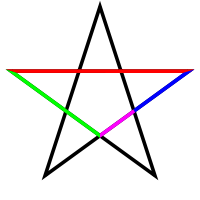Cure: Difference between revisions
en>Brainmachine |
en>WhatamIdoing Undid revision 564698392 by 131.125.56.193 (talk) |
||
| Line 1: | Line 1: | ||
<noinclude><div style="float:left; width:55%;"> | |||
{{Portal:Geometry/box-header|Selected Article|Portal:Geometry/Selected article/1}}</noinclude> | |||
{| style="float: right; margin-left: 1em; background-color: transparent; " | |||
|- | |||
|[[Image:Pentagram-phi.svg|center|200px]] | |||
|- | |||
| width=200 style="font-size: 85%; text-align: center; " | A [[pentagram]] colored to distinguish its line segments of different lengths. The four lengths are in golden ratio to one another | |||
|} | |||
In [[mathematics]] and the [[art]]s, two quantities are in the '''golden ratio''' if the [[ratio]] between the sum of those quantities and the larger one is the same as the ratio between the larger one and the smaller. The golden ratio is a [[mathematical constant]], usually denoted by the [[Greek alphabet|Greek]] letter ''φ'' ([[phi]]). | |||
Expressed algebraically, two quantities ''a'' and ''b'' are therefore in the golden ratio if | |||
:<math> \frac{a+b}{a} = \frac{a}{b} = \varphi\,.</math> | |||
It follows from this property that ''φ'' satisfies the [[quadratic equation]] ''φ''<sup>2</sup> = ''φ'' + 1 and is therefore an [[algebraic number|algebraic]] [[irrational number]], given by | |||
:<math>\varphi = \frac{1 + \sqrt{5}}{2},\,</math> | |||
which is approximately equal to 1.6180339887. | |||
At least since the [[Renaissance]], many [[artist]]s and [[architect]]s have proportioned their works to approximate the golden ratio—especially in the form of the '''[[golden rectangle]]''', in which the ratio of the longer side to the shorter is the golden ratio—believing this proportion to be [[aesthetics|aesthetically]] pleasing. [[Mathematician]]s have studied the golden ratio because of its unique and interesting properties. | |||
Other names frequently used for or closely related to the golden ratio are '''golden section''' (Latin: ''sectio aurea''), '''golden mean''', '''golden number''', '''divine proportion''' (Italian: ''proporzione divina''), '''divine section''' (Latin: ''sectio divina''), '''golden proportion''', '''golden cut''', and '''mean of [[Phidias]]'''. | |||
{| width="100%" border="0" style="padding: 0; margin:0; background:transparent;" | |||
|align=left|'''[[Portal:Geometry/Selected article|...Archive]]''' | |||
|align=center| <small>Image credit: [[User:PAR]] </small> | |||
|align=right|'''[[Golden ratio|Read more...]]''' | |||
|}<noinclude> | |||
{{Portal:Geometry/box-footer-empty}}</div></noinclude> | |||
Revision as of 21:46, 24 July 2013
Template:Portal:Geometry/box-header
 |
| A pentagram colored to distinguish its line segments of different lengths. The four lengths are in golden ratio to one another |
In mathematics and the arts, two quantities are in the golden ratio if the ratio between the sum of those quantities and the larger one is the same as the ratio between the larger one and the smaller. The golden ratio is a mathematical constant, usually denoted by the Greek letter φ (phi).
Expressed algebraically, two quantities a and b are therefore in the golden ratio if
It follows from this property that φ satisfies the quadratic equation φ2 = φ + 1 and is therefore an algebraic irrational number, given by
which is approximately equal to 1.6180339887.
At least since the Renaissance, many artists and architects have proportioned their works to approximate the golden ratio—especially in the form of the golden rectangle, in which the ratio of the longer side to the shorter is the golden ratio—believing this proportion to be aesthetically pleasing. Mathematicians have studied the golden ratio because of its unique and interesting properties.
Other names frequently used for or closely related to the golden ratio are golden section (Latin: sectio aurea), golden mean, golden number, divine proportion (Italian: proporzione divina), divine section (Latin: sectio divina), golden proportion, golden cut, and mean of Phidias.
| ...Archive | Image credit: User:PAR | Read more... |

